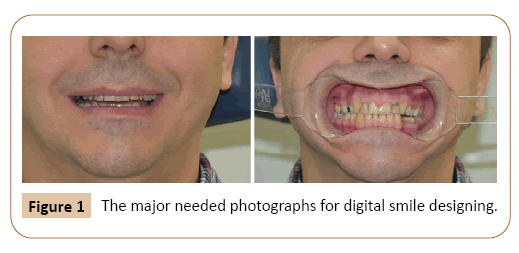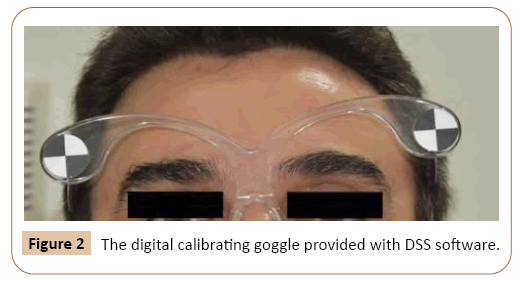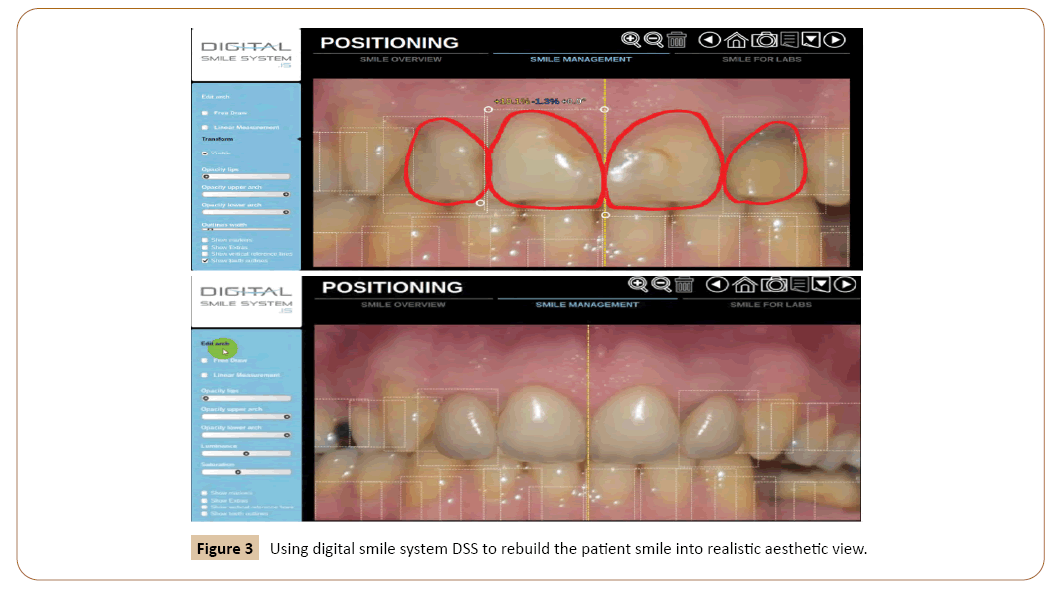Dr. Muaiyed M. Buzayan*
Department of Restorative Medicine, Faculty of Dentistry, University of Malaya, Kuala Lumpur, Malaysia
- *Corresponding Author:
- Dr. Muaiyed M. Buzayan
Department of Restorative Dentistry
Faculty of Dentistry, University of Malaya
Kuala Lumpur, Malaysia
E-mail: muaiyed_zyan@hotmail.com
Received Date: December 10, 2019; Accepted Date: December 15, 2019; Published Date: December 20, 2019
Citation: Dr. Buzayan MM (2019) The Aesthetic Smile Designing in the Digital Dentistry Era. Periodon Prosthodon Vol.5 No.1:48
The rehabilitation treatment planning for most of the aesthetic cases is following very similar diagnosis and analysis phases to achieve good and satisfactory final result [1]. The major aim of these protocols is to clarify any aesthetic discrepancy as well as to guide following decisions. The conventional prosthodontics workflows for these restorations using diagnostic waxing, Mockup, clinical trial restorations, and provisional restorations, in addition to the smile analysis may help in providing adequate communication with both the patient and the dental laboratory technician. However, human errors and faults might occur during such manual procedures, leading to discrepancies in the planned restorations, what might also increase the time needed and costs. Now-a-days, the prosthodontics workflow is getting more and more digitalized, especially in the current digital dentistry era. The digital dentistry is improving and enhancing the aesthetic results with minimizing both the errors and the needed time [2,3].
Commentary
The rehabilitation treatment planning for most of the aesthetic cases is following very similar diagnosis and analysis phases to achieve good and satisfactory final result [1]. The major aim of these protocols is to clarify any aesthetic discrepancy as well as to guide following decisions. The conventional prosthodontics workflows for these restorations using diagnostic waxing, Mockup, clinical trial restorations, and provisional restorations, in addition to the smile analysis may help in providing adequate communication with both the patient and the dental laboratory technician. However, human errors and faults might occur during such manual procedures, leading to discrepancies in the planned restorations, what might also increase the time needed and costs. Now-a-days, the prosthodontics workflow is getting more and more digitalized, especially in the current digital dentistry era. The digital dentistry is improving and enhancing the aesthetic results with minimizing both the errors and the needed time [2,3].
The digital smile designing concept is a practical diagnosis method that enable the clinician to visualize and evaluate orofacial discrepancies. Hence, the digital smile analysis is a crucial step in the diagnosis and treatment planning for aesthetic zone restorations. And this is not only include the analysis of the oral part, it should analyse the smile considering the orodentofacial relationship as well. With few but accurate photographs digital planning offers simple steps to evaluate and predict size, form and tooth position as well as gingival contour [4,5].
Several smile designing software programs are available, I used to design my patients’ smile digitally and always the results were satisfying for both me as a clinician and for my own patients. At the beginning, I used the digital smile design concept introduced by Dr. Coachman [6], and I got great results with it, however, currently, I am using another software which I really consider simpler, accurate and yet affordable, the digital smile system software introduced by Just-Digital company from Italy [7,8]. Generally, the steps you need to follow when deigning smile digitally:
1. Taking two photographic photos for both the smile-face frontal view and the retracted mouth showing the intraoral view, both photos should be captured at the same distance and at the same angle (Figure 1).
Figure 1: The major needed photographs for digital smile designing.
2. Calibrate the photos on the digital software with the actual measurement, either by using the calibrating goggles provided with some software programs like the DSS, or by considering the magnification factor between the actual measurement and the digital photos measurement (Figure 2).
Figure 2: The digital calibrating goggle provided with DSS software.
3. Start evaluating the smile parameters [9], like:
a. The facial midline vs. the dental midline
b. The smile arch.
c. Upper lip curve, buccal corridor and upper incisors display.
d. The dental components considering the teeth height, form, width
e. The gingival components considering the gingival form, zenith, amount of its display.
4. Diagnosis of the orofacial discrepancies if any.
5. Rebuilding the smile digitally considering the previous findings, and following the well-established aesthetic guidelines like (Figure 3):
Figure 3: Using digital smile system DSS to rebuild the patient smile into realistic aesthetic view.
a. The width to height ratio for the centrals (75% to 85%).
b. The RED proportion which is proven to be more aesthetic than the golden proportion [10].
c. (1, 2, 3, 4, 5 rule) also can be a good and simpler alternative to the RED proportion [11].
d. (42.2 rule) for aesthetic smile [11].
6. Communicating with the patient and the technician using the end-result.
Digital smile analysis software programs are practical tools with potential to enhance aesthetic diagnosis, simplify communication with the patient, dental technician, and with other clinicians. Therefore, decrease treatment time, increase clinical efficiency, increase patient acceptance and satisfaction and improve the predictability of treatment.
References
- Davis NC (2007) Smile design. Dent Clin North Am 51: 299-318.
- Matthews TG, Blatterfein L, Morrow RM, Payne SH (1978) The anatomy of a smile. J Prosthet Dent 39: 128-134.
- Fabbri G, Cannistraro G, Pulcini C, Sorrentino R (2018) The full-mouth mock-up: A dynamic diagnostic approach (DDA) to test function and esthetics in complex rehabilitations with increased vertical dimension of occlusion. Int J Esthet Dent 13: 460-474.
- Sanchez-Lara A, Chochlidakis KM, Lampraki E, Molinelli R, Molinelli F, et al. (2019) Comprehensive digital approach with the Digital Smile System: A clinical report. J Prosthet Den 121: 10-16.
- Cattoni F, Mastrangelo F, Gherlone EF, Gastaldi E (2016) New Total Digital Smile Planning Technique (3D-DSP) to Fabricate CAD-CAM Mockups for Esthetic Crowns and Veneers. International Journal of Dentistry. 2: 1-5.
- Coachman C, Calamita M (2012) Digital smile design: A tool for treatment planning and communication in esthetic dentistry. Quintessence Dent Technol. 35: 103–111.
- Luca OTV, Carlo B, Cesare C, Fabrizio M, Marco O, et al. (2018) A digital Workflow for an edentulous patient. Spectrum Dialogue 17: 38-48.
- Luca O, Riccardo S, Luca L, Ilaria C, Tommaso V (2018) A digital workflow for an implant retained over denture: A new approach. Biomed J Sci &Tech Res 6: 5.
- Roy S (2005) The eight components of a balanced smile. JCO 39: 155-167.
- Ward D (2007) A study of dentists’ preferred maxillary anterior tooth width proportions: Comparing the recurring esthetic dental proportion to other mathematical and naturally occurring proportions. J Esthet Restor Dent 19: 324-337.
- McLaren EA, Culp L (2013) Smile analysis: The photoshop smile design technique: Part I. Journal of Cosmetic Dentistry 29: 94-108.




